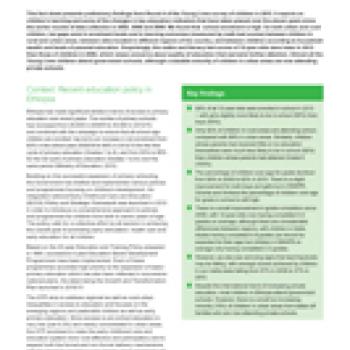
This fact sheet presents preliminary findings from Round 4 of the Young Lives survey of children in 2013. It reports on children?s learning and some of the changes in key education indicators that have taken placed over the eleven years since the earlier rounds of data collection in 2002, 2006 and 2009. We found that school enrolment is high for both urban and rural children, but gaps exist in enrolment levels and in learning outcomes (measured by math test scores) between children in rural and urban areas, between sites located in different regions of the country, and between children according to household wealth and levels of parental education. Surprisingly, the maths and literacy test scores of 12-year-olds were lower in 2013 than those of children in 2006, which raises concerns about quality of education that warrants further attention. Almost all the Young Lives children attend government schools, although a sizeable minority of children in urban areas are now attending private schools.

This fact sheet presents preliminary findings from Round 4 of the Young Lives survey of children in 2013. It reports on children?s learning and some of the changes in key education indicators that have taken placed over the eleven years since the earlier rounds of data collection in 2002, 2006 and 2009. We found that school enrolment is high for both urban and rural children, but gaps exist in enrolment levels and in learning outcomes (measured by math test scores) between children in rural and urban areas, between sites located in different regions of the country, and between children according to household wealth and levels of parental education. Surprisingly, the maths and literacy test scores of 12-year-olds were lower in 2013 than those of children in 2006, which raises concerns about quality of education that warrants further attention. Almost all the Young Lives children attend government schools, although a sizeable minority of children in urban areas are now attending private schools.

